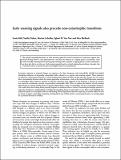Por favor, use este identificador para citar o enlazar a este item:
http://hdl.handle.net/10261/80381COMPARTIR / EXPORTAR:
 SHARE SHARE
 CORE
BASE CORE
BASE
|
|
| Visualizar otros formatos: MARC | Dublin Core | RDF | ORE | MODS | METS | DIDL | DATACITE | |

| Título: | Early warning signals also precede non-catastrophic transitions |
Autor: | Kéfi, Sonia; Dakos, Vasilis CSIC ORCID; Scheffer, M.; van Nes, Egbert H.; Rietkerk, Max | Fecha de publicación: | 2013 | Editor: | Blackwell Publishing | Citación: | Oikos 122: 641- 648 (2013) | Resumen: | Synthesis The quickly expanding literature on early warning signals for critical transitions in ecosystems suggests that critical slowing down is a key phenomenon to measure the distance to a tipping point in ecosystems. Such work is broadly misinterpreted as showing that slowing down is specific to tipping points. In this contribution, we show why this is not the case. Early warning signals based on critical slowing down indicate a broader class of situations where a system becomes increasingly sensitive to perturbations. Ecosystem responses to external changes can surprise us by their abruptness and irreversibility. Models have helped identifying indicators of impending catastrophic shifts, referred to as 'generic early warning signals'. These indicators are linked to a phenomenon known as 'critical slowing down' which describes the fact that the recovery rate of a system after a perturbation decreases when the system approaches a bifurcation - such as the classical fold bifurcation associated to catastrophic shifts. However, contrary to what has sometimes been suggested in the literature, a decrease in recovery rate cannot be considered as specific to approaching catastrophic shifts. Here, we analyze the behavior of early warning signals based on critical slowing down in systems approaching a range of catastrophic and non-catastrophic situations. Our results show that slowing down generally happens in situations where a system is becoming increasingly sensitive to external perturbations, independently of whether the impeding change is catastrophic or not. These results highlight that indicators specific to catastrophic shifts are still lacking. More importantly, they also imply that in systems where we have no reason to expect catastrophic transitions, slowing down may still be used in a more general sense as a warning signal for a potential decrease in stability. © 2012 The Authors. | URI: | http://hdl.handle.net/10261/80381 | DOI: | 10.1111/j.1600-0706.2012.20838.x | Identificadores: | doi: 10.1111/j.1600-0706.2012.20838.x issn: 0030-1299 |
| Aparece en las colecciones: | (EBD) Artículos |
Ficheros en este ítem:
| Fichero | Descripción | Tamaño | Formato | |
|---|---|---|---|---|
| vasili.pdf | 1,99 MB | Adobe PDF |  Visualizar/Abrir |
CORE Recommender
SCOPUSTM
Citations
170
checked on 16-abr-2024
WEB OF SCIENCETM
Citations
156
checked on 28-feb-2024
Page view(s)
389
checked on 19-abr-2024
Download(s)
1.058
checked on 19-abr-2024
Google ScholarTM
Check
Altmetric
Altmetric
NOTA: Los ítems de Digital.CSIC están protegidos por copyright, con todos los derechos reservados, a menos que se indique lo contrario.
